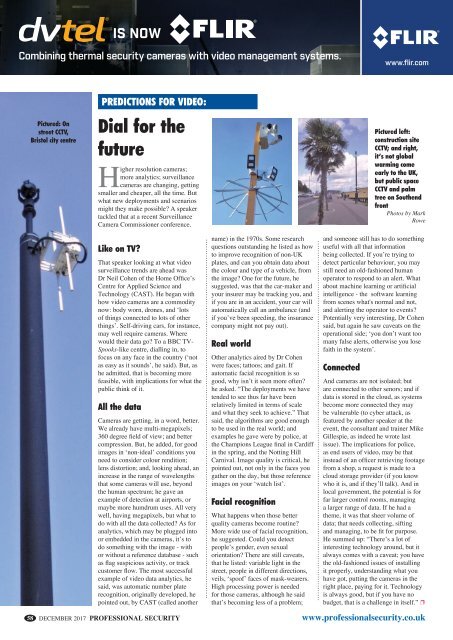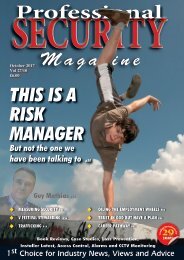Draft27-12
You also want an ePaper? Increase the reach of your titles
YUMPU automatically turns print PDFs into web optimized ePapers that Google loves.
IS NOW<br />
Combining thermal security cameras with video management systems.<br />
www.flir.com<br />
Untitled-20 1 18/02/16 10:18<br />
Pictured: On<br />
street CCTV,<br />
Bristol city centre<br />
predictions for video:<br />
Dial for the<br />
future<br />
Higher resolution cameras;<br />
more analytics; surveillance<br />
cameras are changing, getting<br />
smaller and cheaper, all the time. But<br />
what new deployments and scenarios<br />
might they make possible? A speaker<br />
tackled that at a recent Surveillance<br />
Camera Commissioner conference.<br />
Pictured left:<br />
construction site<br />
CCTV; and right,<br />
it’s not global<br />
warming come<br />
early to the UK,<br />
but public space<br />
CCTV and palm<br />
tree on Southend<br />
front<br />
Photos by Mark<br />
Rowe<br />
58<br />
Like on TV?<br />
That speaker looking at what video<br />
surveillance trends are ahead was<br />
Dr Neil Cohen of the Home Office’s<br />
Centre for Applied Science and<br />
Technology (CAST). He began with<br />
how video cameras are a commodity<br />
now: body worn, drones, and ‘lots<br />
of things connected to lots of other<br />
things’. Self-driving cars, for instance,<br />
may well require cameras. Where<br />
would their data go? To a BBC TV-<br />
Spooks-like centre, dialling in, to<br />
focus on any face in the country (‘not<br />
as easy as it sounds’, he said). But, as<br />
he admitted, that is becoming more<br />
feasible, with implications for what the<br />
public think of it.<br />
All the data<br />
Cameras are getting, in a word, better.<br />
We already have multi-megapixels;<br />
360 degree field of view; and better<br />
compression. But, he added, for good<br />
images in ‘non-ideal’ conditions you<br />
need to consider colour rendition;<br />
lens distortion; and, looking ahead, an<br />
increase in the range of wavelengths<br />
that some cameras will use, beyond<br />
the human spectrum; he gave an<br />
example of detection at airports, or<br />
maybe more humdrum uses. All very<br />
well, having megapixels, but what to<br />
do with all the data collected? As for<br />
analytics, which may be plugged into<br />
or embedded in the cameras, it’s to<br />
do something with the image - with<br />
or without a reference database - such<br />
as flag suspicious activity, or track<br />
customer flow. The most successful<br />
example of video data analytics, he<br />
said, was automatic number plate<br />
recognition, originally developed, he<br />
pointed out, by CAST (called another<br />
DECEMBER 2017 PROFESSIONAL SECURITY<br />
name) in the 1970s. Some research<br />
questions outstanding he listed as how<br />
to improve recognition of non-UK<br />
plates, and can you obtain data about<br />
the colour and type of a vehicle, from<br />
the image? One for the future, he<br />
suggested, was that the car-maker and<br />
your insurer may be tracking you, and<br />
if you are in an accident, your car will<br />
automatically call an ambulance (and<br />
if you’ve been speeding, the insurance<br />
company might not pay out).<br />
Real world<br />
Other analytics aired by Dr Cohen<br />
were faces; tattoos; and gait. If<br />
automatic facial recognition is so<br />
good, why isn’t it seen more often?<br />
he asked. “The deployments we have<br />
tended to see thus far have been<br />
relatively limited in terms of scale<br />
and what they seek to achieve.” That<br />
said, the algorithms are good enough<br />
to be used in the real world; and<br />
examples he gave were by police, at<br />
the Champions League final in Cardiff<br />
in the spring, and the Notting Hill<br />
Carnival. Image quality is critical, he<br />
pointed out, not only in the faces you<br />
gather on the day, but those reference<br />
images on your ‘watch list’.<br />
Facial recognition<br />
What happens when those better<br />
quality cameras become routine?<br />
More wide use of facial recognition,<br />
he suggested. Could you detect<br />
people’s gender, even sexual<br />
orientation? There are still caveats,<br />
that he listed: variable light in the<br />
street, people in different directions,<br />
veils, ‘spoof’ faces of mask-wearers.<br />
High processing power is needed<br />
for those cameras, although he said<br />
that’s becoming less of a problem;<br />
and someone still has to do something<br />
useful with all that information<br />
being collected. If you’re trying to<br />
detect particular behaviour, you may<br />
still need an old-fashioned human<br />
operator to respond to an alert. What<br />
about machine learning or artificial<br />
intelligence - the software learning<br />
from scenes what's normal and not,<br />
and alerting the operator to events?<br />
Potentially very interesting, Dr Cohen<br />
said, but again he saw caveats on the<br />
operational side; ‘you don’t want too<br />
many false alerts, otherwise you lose<br />
faith in the system’.<br />
Connected<br />
And cameras are not isolated; but<br />
are connected to other senors; and if<br />
data is stored in the cloud, as systems<br />
become more connected they may<br />
be vulnerable (to cyber attack, as<br />
featured by another speaker at the<br />
event, the consultant and trainer Mike<br />
Gillespie, as indeed he wrote last<br />
issue). The implications for police,<br />
as end users of video, may be that<br />
instead of an officer retrieving footage<br />
from a shop, a request is made to a<br />
cloud storage provider (if you know<br />
who it is, and if they’ll talk). And in<br />
local government, the potential is for<br />
far larger control rooms, managing<br />
a larger range of data. If he had a<br />
theme, it was that sheer volume of<br />
data; that needs collecting, sifting<br />
and managing, to be fit for purpose.<br />
He summed up: “There’s a lot of<br />
interesting technology around, but it<br />
always comes with a caveat; you have<br />
the old-fashioned issues of installing<br />
it properly, understanding what you<br />
have got, putting the cameras in the<br />
right place, paying for it. Technology<br />
is always good, but if you have no<br />
budget, that is a challenge in itself.” p<br />
www.professionalsecurity.co.uk<br />
p58 Networks 27-<strong>12</strong>.indd 1 18/11/2017 <strong>12</strong>:02










